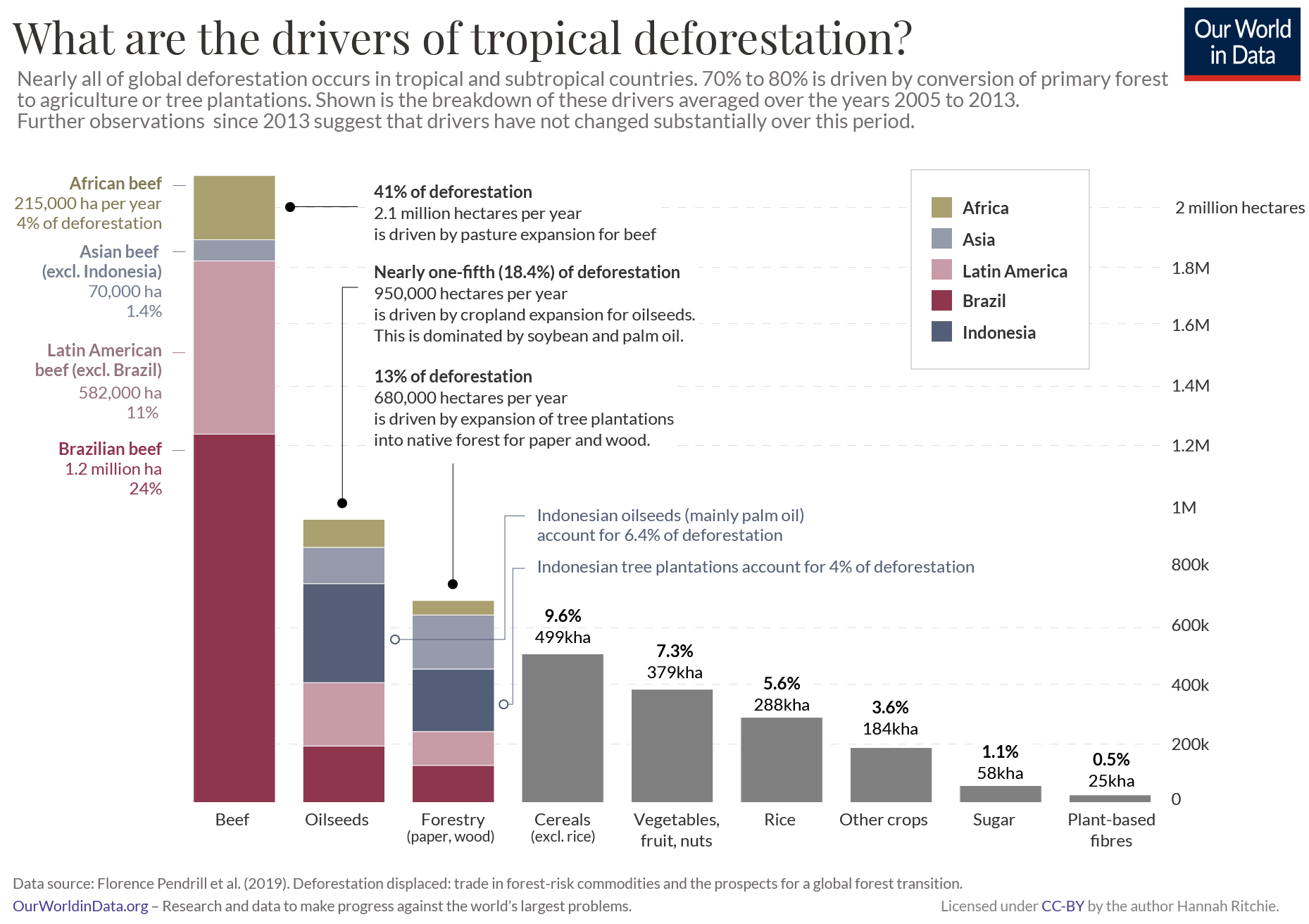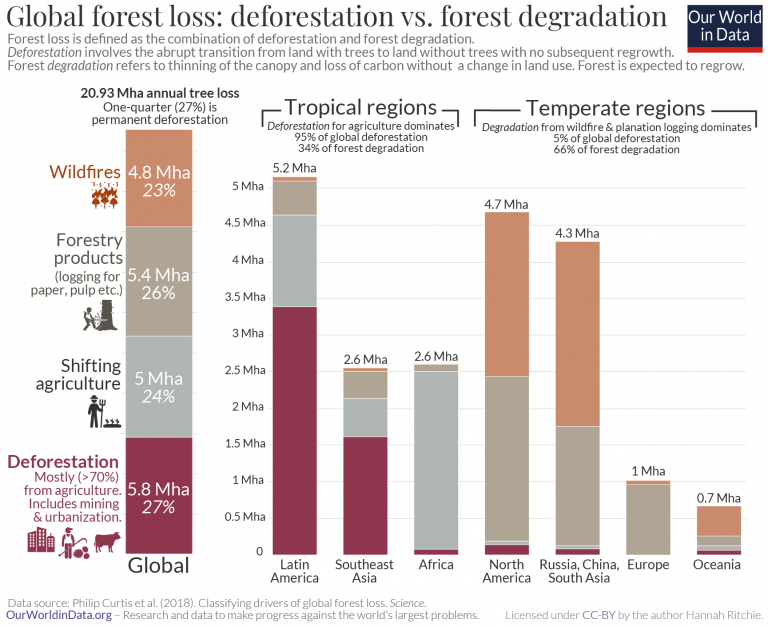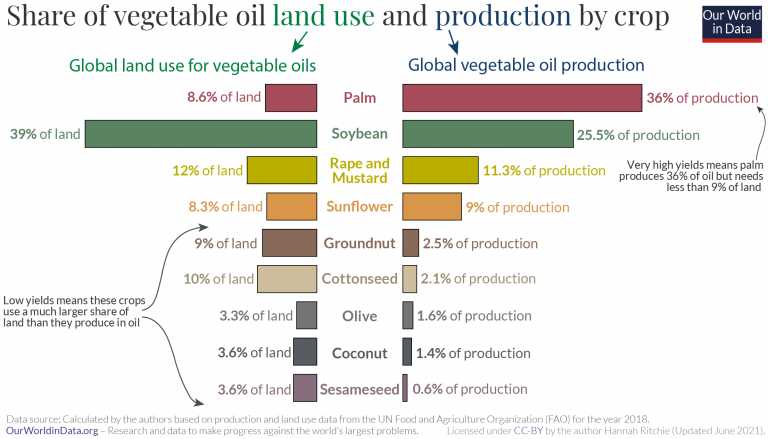Summary
Since the turn of the millennium, the world has been losing around 5 million hectares of forest every year. Nearly all of this occurs in the tropics; almost half of all deforestation takes place in Brazil and Indonesia.
Three-quarters is driven by agriculture. Beef production is responsible for 41% of deforestation; palm oil and soybeans account for another 18%; and logging for paper and wood across the tropics, another 13%. These industries are also dominant in a few key countries.
Effective solutions will be focused on these agricultural activities and those countries where most deforestation occurs.
Every year the world loses around 5 million hectares of forest. 95% of this occurs in the tropics. At least three-quarters of this is driven by agriculture – clearing forests to grow crops, raise livestock and produce products such as paper.1
If we want to tackle deforestation we need to understand two key questions: where we’re losing forests, and what activities are driving it. This allows us to target our efforts towards specific industries, products, or countries where they will have the greatest impact.
In a study published in Global Environmental Change, Florence Pendrill and colleagues addressed both of these questions.2 They quantified how much and where deforestation occurs from the expansion of croplands, pasture and tree plantations (for logging), and what products are grown on this converted land. They also combined this with global trade flows to assess how much of this deforestation was driven by international trade – we look at the role of trade specifically in a related article.
Here we’ll look at both where tropical deforestation is happening and what products are driving it.
The study by Pendrill et al. (2019) found that, between 2005 and 2013, the tropics lost an average of 5.5 million hectares of forest per year to agricultural land. That was a decade ago, but the world is still losing a similar amount today: using satellite data, researchers at Global Forest Watch estimate that global deforestation in 2019 was around 5.4 million hectares.3 95% of this was in the tropics. But where in the tropics did we lose this forest?
In the chart we see the share of tropical deforestation by country and region. It’s measured as the annual average between 2010 and 2014.
One-third of tropical deforestation happened in Brazil. That was 1.7 million hectares each year. The other single country where large forest areas are lost is Indonesia – it accounted for 14%. This means around half (47%) of tropical deforestation took place in Brazil and Indonesia. Again, if we look at more recent satellite data we find that this is still true today: in 2019, the world lost 5.4 million hectares to deforestation, with Brazil and Indonesia accounting for 52% of it.4 As we will see later, the expansion of pasture for beef production, croplands for soy and palm oil, and increasingly conversion of primary forest to tree plantations for paper and pulp have been the key drivers of this.
The expansion of pasture lands have also had a major impact on land use in the rest of the Americas – outside of Brazil, Latin America accounted for around one-fifth of deforestation.
The expansion of agricultural land in Africa accounted for around 17.5% of deforestation. This may slightly underestimate the loss of forests in Africa, for two reasons. Much of Africa’s deforestation has been driven by subsistence agricultural activities, which are not always fully captured in national statistics. Secondly, depending on the permanence of agricultural activities such as slash-and-burn farming, some of this forest loss might be classified as temporary forest degradation rather than permanent deforestation.
If we want to tackle deforestation we also need to know what causes it. That allows us to avoid the foods that drive deforestation or innovate the ways we produce them.
In the chart here we see the breakdown of tropical deforestation by the types of agricultural production.
Beef stands out immediately. The expansion of pasture land to raise cattle was responsible for 41% of tropical deforestation. That’s 2.1 million hectares every year – about half the size of the Netherlands. Most of this converted land came from Brazil; its expansion of beef production accounts for one-quarter (24%) of tropical deforestation. This also means that most (72%) deforestation in Brazil is driven by cattle ranching.5 Cattle in other parts of Latin America – such as Argentina and Paraguay – also accounted for a large amount of deforestation – 11% of the total. Most deforestation for beef therefore occurs in Latin America, with another 4% happening in Africa.
Palm oil and soy often claim the headlines for their environmental impact. They are categorised as ‘oilseeds’, which also include a range of smaller commodities such as sunflower, rapeseed, and sesame. They drove 18% of deforestation. Here we see that Indonesian palm oil was the biggest component of this. In neighbouring Malaysia the expansion of oil seeds was also a major driver of forest loss. Soybeans are the most common oilseed in Latin America. While many people immediately think of food products such as tofu or soy milk, most of global soybean production is used as feed for livestock, or biofuels. Just 6% is used for direct human food. The impact of soy production is one we look at in more detail in a related article.
Combined, beef and oilseeds account for nearly 60% of deforestation.
If we add the third largest driver – forestry products, which is dominated by paper but also includes timber – then we cover almost three-quarters. Across Europe and North America, forestry products mainly come from managed plantation forests that have been established for a long period of time, or are grown on previously unforested land. This is different from most tropical countries where forestry products also come from the logging of primary rainforests or their replacement with plantations. This destroys primary rainforests and, as shown in the chart, has been an important driver of deforestation in Indonesia and elsewhere in Asia.
If almost three-quarters of tropical deforestation is driven by the production of a few key products – beef, soybeans, palm oil, and paper – then we can achieve a lot by focusing our efforts on these supply chains.
There are some signs that progress is possible. Soybean production in Brazil was once also an important driver of deforestation in the Amazon region.6 In 2006, under pressure from retailers and NGOs, the world’s major soybean traders signed Brazil’s Soy Moratorium (SoyM) – the world’s first voluntary zero-deforestation agreement. Traders agreed that they would not purchase soy that was grown on deforested lands in the Brazilian Amazon after July 2006. Overall, it was a success: in the two years before the agreement, 30% of soybean expansion in the region came at the expense of forest; afterwards, deforestation declined dramatically and by 2014 only 1% of expansion was turning forests into land for oilseed production.7,8
But, as we show in our article on the impact of soy, there are also lessons to learn about how to implement these commitments more effectively. There is evidence that while the moratorium reduced deforestation rates in the Brazilian Amazon, some of this deforestation may have ‘leaked’ to neighbouring regions. Soybean production has shifted from the Amazon to the Cerrado region south of the Amazonas, often at the expense of forests there.9 This suggests that zero-deforestation agreements can be effective but must be considered in the wider context of how they shape forest and agricultural changes elsewhere. To combat this, researchers have suggested the SoyM be expanded to not only include the Amazon but also regions such as the Cerrado.10
If we can take similar action in the other industries – beef, palm oil and paper – then there is the potential to cut out a large share of deforestation today.
Looking to the future, a shift in focus towards Sub-Saharan Africa looks likely. The demands for increased agricultural production in Africa are going to be large, and could come at the cost of forests.11 Solutions there will have to focus on major improvements in crop yields so African farmers can produce more food without increasing the amount of land they need to do so.
Alternative ways of making high-quality protein could also be transformative. Beef is the leading driver of deforestation, and the demand for meat across the world will continue to grow in the coming decades. Technological innovations in meat substitute and cultured meat products would allow people to continue eating meat-like products without the destruction of tropical forests that come with it.




